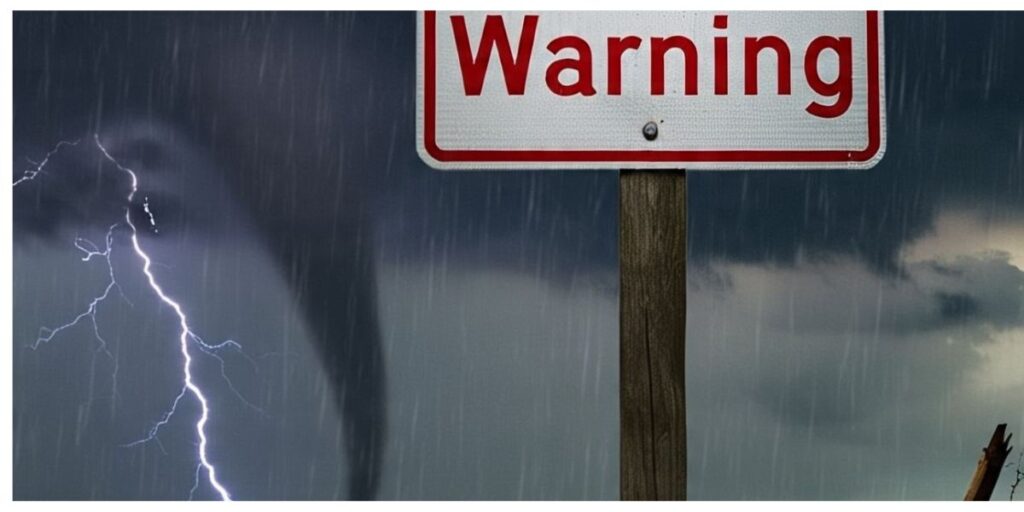Tornado warnings hit differently. Whether you’re sipping your coffee or casually scrolling through your phone, and suddenly, that blaring siren or alert pops up—it rattles you. Because that’s not just weather trivia. That’s “drop everything, protect your life” serious.
But here’s the problem: most folks don’t know what a tornado warning really means or what they’re supposed to do next. So let’s fix that. Whether you’re chilling in Oklahoma, road-tripping through Kansas, or just dealing with spring’s unpredictable chaos, these 10 essential facts will help you stay ahead of the storm.

1. So, What Is a Tornado Warning—and Who’s Behind It?
Let’s clear this up first. A tornado warning isn’t just someone guessing. It’s an official alert, issued by the National Weather Service (NWS), backed by real-time radar data or verified storm spotter reports. This isn’t some AI bot spitting out predictions—these are trained meteorologists who see rotation patterns in the sky and go, “Yep, this could touch down right now.”
Think of it like the fire alarm at school: it’s not there for decoration. When it sounds, action isn’t optional. You’re either moving or risking serious consequences.
2. Watch vs. Warning—Wait, Which One Means Run?
A lot of people mix these two up, and honestly? It’s easy to confuse.
Here’s the quick breakdown:
- Tornado Watch = Conditions are ripe for a tornado. Think of it as “ingredients are on the table.” Storms could start brewing.
- Tornado Warning = A tornado is either spotted or confirmed via radar. This is “oven’s on, and something’s cooking fast.”
You hear “watch,” you stay alert. You hear “warning,” you act immediately. No “just five more minutes” nonsense.
3. What Triggers a Tornado Warning?
You might wonder, “Are they just guessing?” Nope. Not even close.
Warnings are triggered in one of two main ways:
- Radar Indication: Meteorologists use Doppler radar to detect hook echoes or rotational signatures that often suggest a tornado funnel is forming or on the ground.
- Spotter Confirmation: Trained storm spotters or chasers (yes, those wild folks who drive toward the storm) send in verified reports.
Sometimes it’s a combo of both. And when that happens, boom—the warning gets pushed out fast. Like, seconds count kind of fast.
4. How Will I Know If There’s a Tornado Warning Where I Live?
This one’s important, especially if you’re a night owl or heavy sleeper. The key? Get alerts that won’t let you ignore them.
Here’s what works best:
- Wireless Emergency Alerts (WEA): Built into most smartphones. Loud, jarring, but effective.
- NOAA Weather Radio: Old-school but reliable. Works even when cell service drops.
- Apps like The Weather Channel, AccuWeather, or RadarScope: These offer real-time alerts, detailed radar, and location tracking.
- Local TV and Radio Stations: Still a go-to during fast-moving outbreaks.
Pro tip: Don’t rely on just one source. Tech can fail. Multiple backups mean you stay covered—even when power or cell towers don’t cooperate.
5. Got a Warning? Here’s What You Do Right Now
No time to second-guess. When a tornado warning hits, your first thought should be, “Where’s my safe spot?”
Here’s a rapid-fire checklist:
- Get indoors ASAP—mobile homes don’t cut it.
- Head to a basement. No basement? Go to a small, windowless interior room on the lowest floor.
- Avoid windows like they’re lava. Flying glass is brutal.
- Crouch low, face down, hands over your head. A helmet or pillow for head protection is a bonus.
Also, ditch the idea of driving away from the tornado. Unless you’re already far ahead of it, trying to “outrun” a twister is one of those movie things that’ll get you hurt.
6. Where’s the Actual Safest Place During a Tornado Warning?
Ah, the age-old debate: bathroom vs. hallway vs. basement.

Here’s the lowdown:
- Basement: Always the gold standard. Get under something sturdy—like a table—if you can.
- Bathroom: Second best, especially one without windows. The plumbing framework adds a layer of structural strength.
- Hallway or Closet: Small, enclosed spaces away from exterior walls are better than large rooms or anywhere with glass.
Don’t huddle under a highway overpass. That myth can cost lives—wind gets funneled and becomes stronger there.
7. How Long Do Tornado Warnings Usually Last?
Short but intense.
Tornado warnings typically last about 30 minutes or less, depending on the storm’s movement. Some expire quickly, while others get extended if the tornado stays active or the system is spawning more.
During that time, don’t assume it’s over just because it’s quiet. Tornadoes are sneaky. They can shift, reform, or move unpredictably.
Wait for the all-clear from a reliable source before stepping out of your shelter zone.
8. Can a Tornado Warning Be…Wrong?
Honestly? Yeah, sometimes.
Not every warning leads to a confirmed tornado. But here’s the thing: meteorologists would rather issue a false alarm than miss a real one. The radar might show strong rotation that never becomes a touchdown, but that’s not something you gamble on.
Statistically, warnings are right more often than not. And those few “false” alarms? They’re better than regrets. You don’t want to be the guy saying, “Thought it was nothing,” while watching your neighbor’s garage take flight.
9. What Emergency Supplies Should I Keep Handy?
You can’t grab things when seconds count, so prep matters.
Here’s a tight, no-fluff checklist for a tornado emergency kit:
- Flashlight (and extra batteries)
- Phone charger/power bank
- Bottled water and snacks (protein bars are clutch)
- First-aid kit
- Whistle or noise-making device (for signaling)
- Copies of important documents (ID, insurance)
- Blanket or emergency thermal wrap
- Sturdy shoes (yes, even if you’re barefoot inside)
If you’ve got little ones or pets, customize your kit—formula, meds, leashes, diapers—whatever you need in one grab-and-go bag.
10. How Do I Prepare My Family for Tornado Warnings?

Preparedness isn’t just gear—it’s muscle memory.
Here’s how to get everyone ready without making it scary:
- Run drills every few months. Pick a safe spot and practice going there fast.
- Teach your kids to recognize the alert sounds.
- Make a habit of checking weather forecasts during stormy seasons (spring’s the usual tornado troublemaker).
- Keep shoes and flashlights in known spots—consistency is your friend.
Even if you live somewhere where tornadoes are rare, one weird weather week can change that. Being “kinda prepared” isn’t enough.
🚨 Bonus: Real-Time Alert Tools That Work
Here’s a shortlist of apps and tools we mentioned earlier—because finding them mid-storm is not the vibe:
- NOAA Weather Radar Live
- The Weather Channel app
- AccuWeather
- MyRadar
- FEMA app (Solid for overall emergency alerts)
- Wireless Emergency Alerts (Automatically on in newer phones)
Also, follow your local NWS office on Twitter/X—they’re fast and hyperlocal with alerts.
Conclusion:
Look—no one’s trying to freak you out. But tornadoes are unforgiving. One minute, you’re binge-watching Netflix. Next, sirens blare, and you’ve got seconds to act.
These warnings? They give you a fighting chance. Whether it’s 10 minutes or 30, that time is everything.
So next time your phone screeches with a tornado warning—don’t ignore it. Don’t debate it. Just move. Because staying ready isn’t being paranoid—it’s being smart.
And you know what? Your future self will thank you.











Leave a Reply